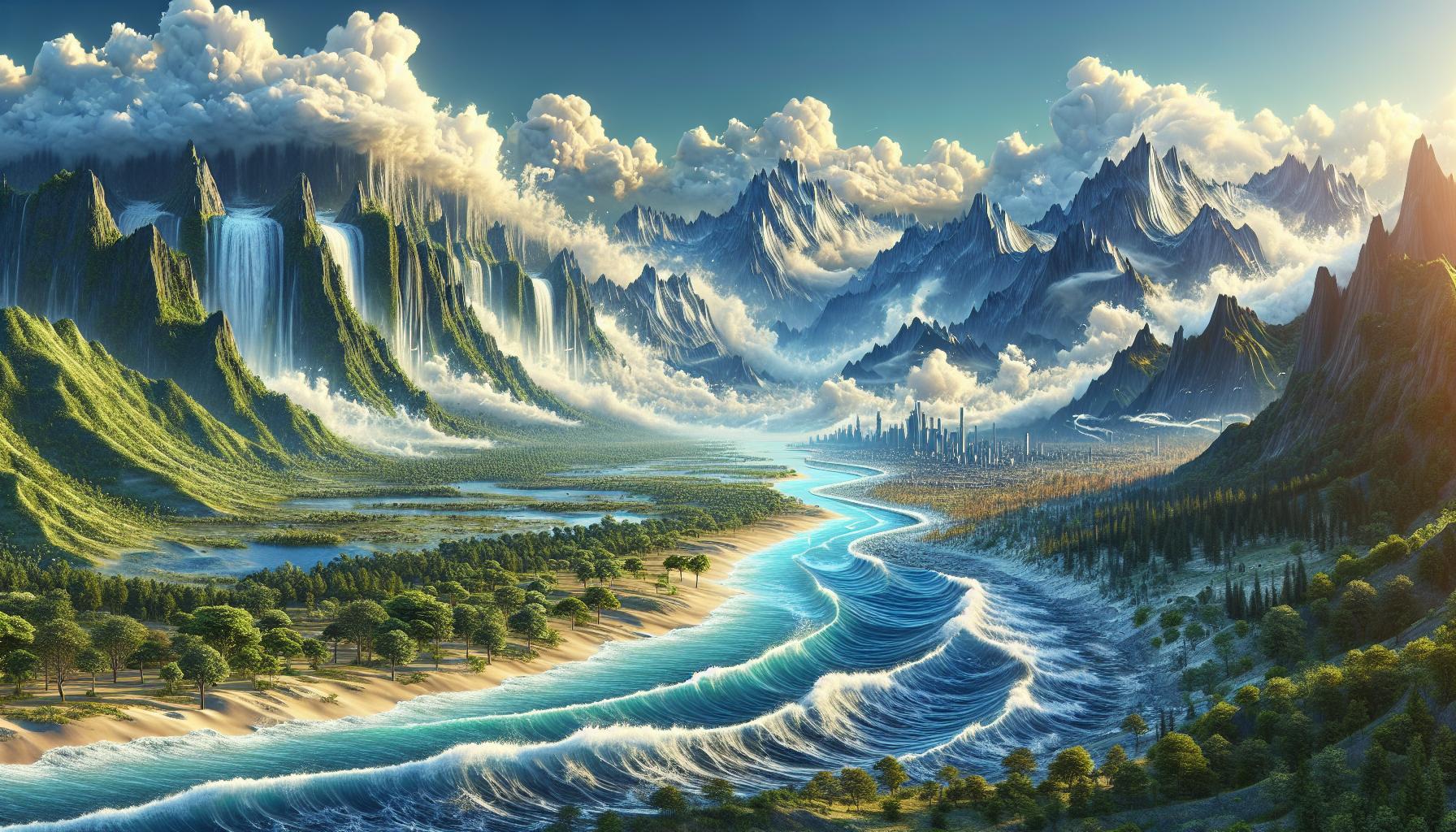Water’s endless journey through Earth’s ecosystems is nothing short of magical. The water cycle, also known as the hydrologic cycle, keeps life flowing on our blue planet through an intricate dance of evaporation, condensation and precipitation.
From the tiniest raindrop to the mightiest ocean, water transforms and travels in a perpetual loop that’s been running smoothly for billions of years. This remarkable process doesn’t just keep plants hydrated and rivers flowing – it’s the cornerstone of all life as we know it. Think of it as nature’s ultimate recycling system, where not a single drop goes to waste.
The water cycle impacts everything from weather patterns to drinking water availability. Understanding its complexities helps us appreciate how interconnected Earth’s systems truly are and why protecting this delicate balance is crucial for our planet’s future.
Esquema:5xiuo49djku= Ciclo Del Agua
Water moves through three distinct phases in the hydrologic cycle: liquid, gas, and solid. The cycle begins as solar radiation heats surface water bodies, causing evaporation into the atmosphere. This process transforms water from its liquid state into water vapor.
Evaporation and Transpiration
Plants release water vapor through tiny pores in their leaves during transpiration. This combined process of evaporation from surface water and transpiration from vegetation creates a steady stream of water vapor rising into the atmosphere.
| Water Cycle Phase | Temperature Range (°C) | Process Time |
|---|---|---|
| Evaporation | 0-100 | Minutes to hours |
| Transpiration | 20-40 | Hours to days |
| Condensation | Below dew point | Minutes |
| Precipitation | Variable | Minutes |
Condensation and Cloud Formation
As water vapor rises, it cools at higher altitudes forming tiny water droplets. These droplets cluster together around dust particles creating clouds or fog. The accumulation of water droplets leads to cloud formation at varying atmospheric levels.
Precipitation and Collection
When water droplets become too heavy, they fall as precipitation in various forms:
- Rain drops in warm conditions
- Snow crystals in freezing temperatures
- Hail during severe storms
- Sleet in mixed temperature conditions
Surface water collects in:
- Lakes
- Rivers
- Oceans
- Groundwater aquifers
- Soil moisture reserves
This continuous movement of water maintains Earth’s temperature balance while supporting all forms of life. The cycle repeats indefinitely, driven by solar energy and gravity’s constant influence on water molecules.
Key Stages of the Water Cycle

The water cycle consists of three primary stages that continuously transform water between different states. Each stage plays a distinct role in maintaining Earth’s water distribution system through specific physical processes.
Evaporation From Water Bodies
Solar radiation heats surface water bodies at temperatures between 0-100°C (32-212°F), converting liquid water into water vapor. Oceans contribute 80% of atmospheric water vapor through evaporation. Lakes, rivers and streams account for an additional 16% of evaporated water. Plants release water vapor through transpiration, adding 4% to the atmospheric moisture content. This process transfers approximately 495,000 cubic kilometers of water into the atmosphere annually.
Condensation in the Atmosphere
Water vapor rises to altitudes of 1-15 kilometers where cooler temperatures cause it to condense into microscopic water droplets. These droplets collect around dust particles, forming clouds when the air reaches 100% relative humidity. Low-level clouds form at 2 kilometers while high-level clouds develop at 10 kilometers. Cloud droplets measure 0.02 millimeters in diameter, requiring about 1 million droplets to form a single raindrop.
Precipitation Back to Earth
Condensed water droplets fall as precipitation when they reach 0.5 millimeters in diameter. Rain occurs at temperatures above 0°C (32°F), while snow forms below freezing. Annual global precipitation averages 1,000 millimeters, with 78% falling over oceans. Tropical regions receive up to 2,000 millimeters yearly, while deserts get less than 250 millimeters. Lightning storms generate 2% of Earth’s precipitation through electrical charge separation in clouds.
The Role of Solar Energy

Solar energy functions as the primary driver of Earth’s water cycle through direct heat transfer to water surfaces. The sun’s radiation delivers 173,000 terawatts of energy to Earth, with 23% dedicated to powering the water cycle.
Solar radiation impacts the water cycle in three key ways:
- Heats surface water to initiate evaporation
- Energizes air molecules to increase water vapor capacity
- Powers plant transpiration processes
The sun’s energy creates temperature differences that affect water movement:
| Temperature Zone | Effect on Water Cycle |
|---|---|
| Surface Water | 0-100°C evaporation range |
| Lower Atmosphere | 15-30°C vapor transport |
| Upper Atmosphere | -40°C cloud formation |
Heat from solar radiation triggers molecular changes in water:
- Breaks hydrogen bonds between molecules
- Increases kinetic energy of water particles
- Transforms liquid water into water vapor
Plants utilize solar energy through photosynthesis to facilitate transpiration:
- Absorbs sunlight through leaves
- Opens stomatal pores
- Releases water vapor into atmosphere
- Contributes 10% of atmospheric moisture
Solar intensity variations create global water cycle patterns:
- Stronger at equatorial regions
- Weaker at polar areas
- Creates distinct precipitation zones
- Forms predictable weather systems
The sun’s daily cycle influences evaporation rates with peak activity occurring during midday hours when solar radiation reaches maximum intensity.
Water Cycle’s Impact on Climate

The water cycle shapes Earth’s climate by regulating temperature distribution and atmospheric moisture content across regions. Its influence extends from local weather patterns to global climate systems through heat transfer and water vapor movement.
Regional Weather Patterns
Regional weather patterns emerge from interactions between the water cycle and local geographical features. Mountains force moist air upward, creating orographic precipitation on windward slopes while leaving leeward sides dry. Coastal areas experience higher rainfall due to increased evaporation from nearby water bodies. Large bodies of water moderate local temperatures by absorbing heat during summer and releasing it in winter. Urban areas alter precipitation patterns through heat island effects, increasing convection and thunderstorm frequency by 20-30%. These localized water cycle variations create distinct microclimates within regions.
Global Climate Systems
The water cycle drives global climate systems through oceanic currents and atmospheric circulation patterns. Ocean currents transport heat from equatorial regions to higher latitudes, with the Gulf Stream moving 150 million cubic meters of water per second. Water vapor acts as a greenhouse gas, trapping heat and accounting for 60% of the natural greenhouse effect. Trade winds carry moisture across continents, creating consistent precipitation bands near the equator. El Niño Southern Oscillation cycles alter global precipitation patterns every 3-7 years, affecting temperature distribution across the Pacific Ocean basin. Atmospheric rivers transport 90% of Earth’s meridional water vapor flux, delivering essential precipitation to mid-latitude regions.
Human Activities Affecting the Water Cycle
Industrial operations release greenhouse gases that alter atmospheric temperatures, disrupting natural evaporation rates. Manufacturing processes consume 22% of global freshwater resources, reducing available surface water for natural cycle processes.
Urban development creates impermeable surfaces like concrete pavements roads that:
- Block natural ground absorption
- Increase surface runoff by 55%
- Reduce groundwater recharge rates
- Accelerate erosion in surrounding areas
Agricultural practices impact the water cycle through:
- Irrigation systems diverting 70% of freshwater resources
- Chemical fertilizers contaminating groundwater aquifers
- Soil compaction reducing natural infiltration
- Deforestation decreasing transpiration rates by 30%
| Human Activity | Impact on Water Cycle | Percentage Change |
|---|---|---|
| Urbanization | Surface Runoff Increase | 55% |
| Agriculture | Water Resource Usage | 70% |
| Deforestation | Transpiration Reduction | 30% |
| Industry | Freshwater Consumption | 22% |
Dam construction alters natural water flow patterns by:
- Creating artificial reservoirs
- Modifying downstream ecosystems
- Changing local precipitation patterns
- Affecting groundwater distribution
Water pollution from industrial discharges chemical spills introduces contaminants that:
- Alter water chemistry
- Disrupt aquatic ecosystems
- Reduce evaporation rates
- Contaminate precipitation
- Global precipitation patterns
- Ocean circulation systems
- Glacial melt rates
- Extreme weather frequency
Maintaining Nature’s Water Balance
Natural ecosystems maintain water balance through specialized adaptations. Forests regulate water distribution by intercepting 20% of rainfall through their canopy systems. Wetlands act as natural filters, processing 7,500 gallons of water per acre daily through biological mechanisms.
Groundwater aquifers store 30.1% of Earth’s freshwater reserves beneath the surface. Root systems enhance soil permeability, increasing water infiltration rates by 40%. Marine ecosystems circulate 100 billion tons of water daily through thermohaline circulation.
| Ecosystem Type | Water Processing Capacity | Role in Water Balance |
|---|---|---|
| Forests | 20% rainfall interception | Canopy regulation |
| Wetlands | 7,500 gallons/acre/day | Filtration & storage |
| Aquifers | 30.1% freshwater storage | Underground reserves |
| Marine | 100B tons daily circulation | Global distribution |
Native vegetation plays critical roles in maintaining local water cycles:
- Absorbing excess rainfall through deep root networks
- Creating microhabitats that reduce evaporation rates
- Converting surface water to atmospheric moisture through transpiration
- Stabilizing soil structure to prevent erosion
- Filtering pollutants from water systems
Coastal ecosystems contribute to water balance through:
- Processing 12 million gallons of seawater per square mile daily
- Converting 15% of surface water into atmospheric moisture
- Maintaining salinity gradients in estuarine zones
- Protecting inland areas from storm surge impacts
- Supporting marine precipitation cycles
- Urban development reduces permeable surfaces by 65%
- Agricultural practices alter soil absorption rates
- Industrial operations contaminate water sources
- Deforestation decreases natural water retention
- Infrastructure projects modify drainage patterns
Planet’s Water Cycle
Our planet’s water cycle stands as a remarkable testament to nature’s perfect balance. This intricate system not only sustains life but also regulates Earth’s climate while maintaining essential ecosystems. As human activities continue to impact this delicate cycle understanding and protecting it becomes increasingly crucial.
The future of Earth’s water resources depends on implementing sustainable practices and reducing environmental disruptions. By recognizing the water cycle’s vital role in our planet’s health we can work toward preserving this precious resource for generations to come.
Each individual action counts in safeguarding the natural processes that have sustained life for millions of years. The water cycle’s resilience reminds us that nature’s systems are both powerful and fragile requiring our careful stewardship.

